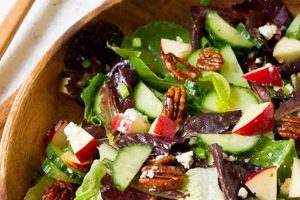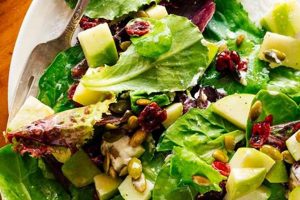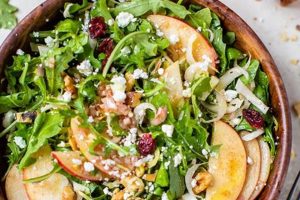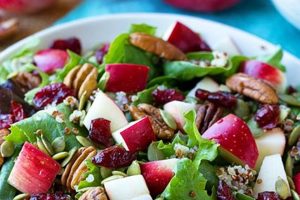A basic fruit salad featuring apples as the primary ingredient typically includes a combination of complementary flavors and textures. Common additions might involve other fruits like grapes or berries, crunchy elements such as celery or walnuts, and a light dressing, perhaps incorporating yogurt, mayonnaise, or a simple vinaigrette. An example could be sliced apples tossed with chopped grapes, celery, walnuts, and a dressing of mayonnaise and lemon juice.
Such salads offer a refreshing and nutritious dish, ideal as a light lunch, side dish, or healthy snack. The readily available ingredients and minimal preparation time make them convenient and accessible. Apples provide fiber and vitamins, contributing to overall well-being. Variations on this fundamental recipe have been enjoyed for generations, adapting to seasonal availability and regional preferences. The simplicity of this dish makes it a gateway to culinary exploration, allowing for experimentation with diverse ingredients and dressings.
This foundational concept can be explored further through discussions on specific ingredient selections, dressing variations, and techniques for achieving optimal flavor and texture. Additional topics might include nutritional information, creative presentation ideas, and adaptations for dietary restrictions.
Tips for Creating a Delicious Apple Salad
The following tips offer guidance on elevating a basic apple salad from simple to exceptional.
Tip 1: Select the Right Apples: Choose varieties that hold their shape and offer a balance of sweetness and tartness. Honeycrisp, Fuji, and Braeburn are excellent choices. Avoid apples that become mushy quickly, such as Red Delicious.
Tip 2: Prevent Browning: To maintain the apples’ appealing appearance, toss them with a little lemon juice or an ascorbic acid solution immediately after slicing. This inhibits oxidation and preserves freshness.
Tip 3: Add Textural Contrast: Incorporate ingredients with contrasting textures for a more engaging culinary experience. Nuts, seeds, dried cranberries, or chopped celery provide satisfying crunch.
Tip 4: Enhance the Flavor Profile: Experiment with complementary flavors. Consider incorporating cheeses like crumbled blue cheese or cheddar, dried fruits, or spices such as cinnamon or nutmeg.
Tip 5: Dress Lightly: Avoid overpowering the delicate apple flavor with heavy dressings. A simple vinaigrette, a light coating of mayonnaise combined with yogurt, or a sprinkle of lemon juice often suffices.
Tip 6: Time the Dressing Application: Dress the salad shortly before serving to prevent the ingredients from becoming soggy. This preserves the desired crispness and texture.
Tip 7: Consider Seasonal Ingredients: Embrace seasonal fruits and vegetables for optimal flavor and freshness. In autumn, consider adding roasted butternut squash or pecans. During summer, fresh berries provide a refreshing complement.
By following these suggestions, one can achieve a flavorful and visually appealing apple salad that offers both nutritional value and culinary satisfaction.
These insights provide a solid foundation for crafting an exceptional dish. The following section will explore various recipe variations and serving suggestions.
1. Fresh, Crisp Apples
The foundation of a successful simple apple salad rests upon the quality of its core ingredient: fresh, crisp apples. Selecting the appropriate apple variety and ensuring its optimal freshness significantly impacts the final dish’s flavor, texture, and overall appeal. This section explores the crucial role of apple selection in creating a delightful salad.
- Variety Selection
Different apple varieties offer unique flavor profiles and textures. A Honeycrisp provides a balanced sweetness and satisfying crunch, while a Granny Smith contributes a tartness that complements sweeter additions. Choosing apples that retain their structure after slicing, such as Fuji or Braeburn, is crucial for preventing a mushy salad. Softer varieties like Red Delicious are less suitable. Careful varietal selection allows for tailoring the salad’s flavor profile to individual preferences.
- Indicators of Freshness
Identifying fresh apples involves assessing several key indicators. Firmness to the touch, vibrant skin color free from blemishes, and a pleasant aroma signify freshness. Avoiding apples with bruises, soft spots, or a dull appearance ensures optimal flavor and texture. Freshly harvested apples generally offer the best quality for salads.
- Storage and Preservation
Proper storage maintains apple freshness. Refrigeration in a crisper drawer helps preserve texture and flavor. To prevent browning after slicing, a light coating of lemon juice or an ascorbic acid solution inhibits oxidation and maintains an appealing appearance. Minimizing exposure to air further slows down enzymatic browning.
- Impact on Overall Salad Quality
Fresh, crisp apples contribute significantly to the overall enjoyment of the salad. Their texture provides a pleasant contrast to other ingredients, and their flavor forms the base of the dish. Using subpar apples compromises both flavor and texture, ultimately diminishing the salad’s appeal. The choice of apple establishes the foundation upon which the other components build, influencing the overall culinary experience.
The selection, handling, and storage of fresh, crisp apples are essential steps in creating a simple apple salad that delights the palate. Prioritizing these elements ensures a satisfying culinary experience, demonstrating that the simplest dishes often benefit most from high-quality ingredients.
2. Complementary Ingredients
Complementary ingredients elevate a simple apple salad from basic to nuanced, transforming a collection of ingredients into a harmonious dish. The interplay of flavors and textures creates a more engaging sensory experience. The success of such a salad hinges on the thoughtful selection of ingredients that enhance, rather than overshadow, the natural flavor of the apples. Crunchy elements provide textural contrast, while sweet or savory additions broaden the flavor profile. Consider the interplay between crisp apples and the creamy richness of walnuts, the tartness of dried cranberries, or the sharpness of crumbled blue cheese. These additions provide depth and complexity.
Several categories of complementary ingredients contribute to a well-rounded apple salad. Nuts and seeds, such as walnuts, pecans, or sunflower seeds, offer a satisfying crunch and healthy fats. Dried fruits, like cranberries or raisins, introduce sweetness and chewiness. Cheeses, including cheddar, blue cheese, or feta, provide salty, savory notes and creamy textures. Vegetables, such as celery, grapes, or fennel, add contrasting crispness and distinct flavors. Careful consideration of these categories ensures a balanced and appealing composition.
Understanding the role of complementary ingredients unlocks the potential of the simple apple salad. Thoughtful pairings create a symphony of flavors and textures, enhancing the overall culinary experience. The strategic incorporation of these elements transforms a basic dish into a satisfying and memorable culinary creation. This principle of balance and contrast extends beyond apple salads, informing the creation of numerous dishes where the considered combination of ingredients elevates the whole.
3. Balanced Dressing
A balanced dressing is crucial for a simple apple salad recipe. It enhances the natural flavors of the apples and other ingredients without overpowering them. A dressing that is too sweet, too tart, or too heavy can detract from the overall balance and freshness of the salad. Achieving this balance involves careful consideration of the dressing’s components: the acid, the fat, the sweetener, and the seasonings.
- Acidity
Acidity provides brightness and helps to cut through the sweetness of the apples. Common acidic ingredients include lemon juice, vinegar (such as apple cider or white wine vinegar), and even a touch of orange juice. The level of acidity should complement the sweetness of the apples and other fruits in the salad. Too much acid can make the salad taste sour, while too little can leave it tasting bland.
- Fat
Fat adds richness and helps to coat the ingredients, distributing the flavors throughout the salad. Common fat sources include olive oil, mayonnaise, Greek yogurt, and even a small amount of cream. The type of fat chosen influences the dressing’s overall flavor and texture. A light olive oil contributes a delicate fruity note, while mayonnaise adds a creamy richness. The amount of fat should be carefully considered; too much can make the salad heavy and greasy.
- Sweetener
A touch of sweetener balances the acidity and adds complexity to the dressing. Honey, maple syrup, or a small amount of sugar are common choices. The sweetness should be subtle and not overpower the other flavors. Some apple varieties, like Honeycrisp, already possess significant sweetness, so the amount of added sweetener should be adjusted accordingly. The goal is to achieve a harmonious balance, not to create a dessert-like salad.
- Seasonings
Seasonings enhance the overall flavor profile of the dressing. Salt and pepper are essential for enhancing the other flavors. Herbs, such as fresh mint, dill, or chives, add aromatic complexity. Spices like cinnamon or nutmeg can complement the apples’ natural sweetness. The seasonings should be used judiciously to avoid overpowering the delicate flavors of the salad. Freshly ground spices generally offer superior flavor compared to pre-ground options.
These four componentsacidity, fat, sweetener, and seasoningswork in concert to create a balanced dressing that enhances the simple apple salad recipe. The careful interplay of these elements ensures that the dressing complements, rather than masks, the natural flavors of the apples and other ingredients. A well-balanced dressing elevates the salad from a simple combination of ingredients to a harmonious and flavorful dish.
4. Proper Preparation
Proper preparation is essential for a simple apple salad recipe to ensure optimal flavor, texture, and presentation. While the ingredient list may be straightforward, the techniques employed significantly influence the final result. Careful attention to detail in each preparatory step elevates the dish from merely acceptable to truly enjoyable. This involves selecting and handling ingredients correctly, employing appropriate cutting techniques, and timing the combination of components effectively.
- Ingredient Selection and Handling
Choosing crisp, flavorful apples is paramount. Apples prone to rapid browning, such as Red Delicious, should be avoided. Firm varieties like Honeycrisp or Braeburn maintain texture and flavor. Inspecting ingredients for blemishes or bruises ensures quality. Proper storage, ideally in a cool environment, preserves freshness. For instance, storing apples in a perforated plastic bag in the refrigerator maintains crispness.
- Cutting Techniques
Uniformity in cutting ensures even distribution of flavor and a pleasing presentation. Slicing apples into consistent sizes and shapes allows the dressing to coat evenly and facilitates even cooking if the recipe involves any heating. Dicing, slicing, or julienning, depending on the desired outcome, contributes to both aesthetic appeal and balanced flavor. For example, thinly slicing apples creates a delicate texture, while thicker slices offer more bite.
- Timing of Combination
The timing of combining ingredients significantly impacts the final salad’s quality. Adding dressing too early can lead to a soggy salad, particularly if the dressing contains acidic components. Delicate ingredients, such as herbs or lettuces, should be added just before serving to maintain their freshness and texture. Combining apples with other ingredients like dried fruit or nuts can be done in advance. However, delaying the addition of dressing preserves the crispness of the apples and prevents sogginess.
- Preventing Browning
Apples are prone to enzymatic browning upon exposure to air. This discoloration, while not harmful, affects the salad’s visual appeal. To prevent this, a light coating of lemon juice or an ascorbic acid solution creates a barrier against oxidation. This step is crucial for maintaining the apples’ fresh appearance, enhancing the overall presentation. This technique preserves the vibrant color and fresh appearance, contributing to a more visually appealing final product.
These seemingly minor preparatory steps contribute significantly to the overall success of a simple apple salad recipe. Attention to detail in ingredient selection, cutting techniques, timing of combination, and prevention of browning elevates the dish from ordinary to exceptional. These techniques demonstrate that even simple recipes benefit from careful execution, highlighting the importance of proper preparation in culinary endeavors. This meticulous approach results in a salad that is not only flavorful but also visually appealing and texturally satisfying.
5. Attractive Presentation
Attractive presentation elevates a simple apple salad recipe from a basic dish to a visually appealing culinary creation. While flavor remains paramount, visual appeal enhances the dining experience, stimulating appetite and adding a touch of elegance. Consideration of color, texture, arrangement, and serving vessel contributes to a presentation that complements the fresh, vibrant flavors of the salad.
- Color Harmony
A visually appealing salad leverages the natural colors of its ingredients. The vibrant hues of apples, ranging from deep reds to bright greens, provide a foundation. Incorporating ingredients with complementary colors, such as the deep purple of grapes or the bright orange of carrots, creates visual interest. A monochromatic approach, using varying shades of green with green apples, celery, and green grapes, can also be effective. Contrasting colors create a dynamic presentation, while analogous colors offer a more harmonious aesthetic.
- Textural Contrast
Visual texture plays a significant role in an appealing presentation. The smooth surface of sliced apples contrasts with the rough texture of chopped nuts or the delicate leafy greens. Incorporating a variety of texturescrunchy, creamy, smoothcreates visual depth and enhances the sensory experience. Consider the visual contrast between the smooth, round surface of grapes and the jagged edges of crumbled blue cheese. This interplay of textures adds visual interest and foreshadows the textural variety experienced when eating the salad.
- Arrangement and Composition
Thoughtful arrangement elevates the presentation. Simply tossing ingredients together creates a rustic look, while a more deliberate arrangement adds a touch of sophistication. Consider arranging apple slices in a circular pattern, creating a frame for other ingredients. Layering ingredients adds height and dimension. Avoid overcrowding the serving dish; allow some negative space to showcase individual components. A well-composed salad is visually engaging and inviting.
- Serving Vessel Selection
The choice of serving vessel influences the overall presentation. A clear glass bowl showcases the vibrant colors and textures of the salad. A rustic wooden bowl adds a natural touch. A shallow platter allows for a more artistic arrangement. The size and shape of the serving vessel should complement the salad’s volume and style. A large, shallow platter works well for a family-style salad, while individual bowls offer a more elegant presentation for smaller portions.
These elements of presentationcolor harmony, textural contrast, arrangement, and serving vesselcontribute significantly to the overall enjoyment of a simple apple salad recipe. While the salad’s flavor remains the primary focus, a visually appealing presentation enhances the dining experience, making it more memorable and satisfying. These visual considerations transform a simple dish into a culinary creation that appeals to both the palate and the eye, demonstrating that even simple recipes deserve thoughtful presentation.
6. Seasonality Considerations
Seasonality significantly impacts the flavor profile and overall quality of a simple apple salad recipe. Utilizing ingredients at their peak freshness elevates the dish, offering superior taste and nutritional value. Considering seasonal produce allows for a dynamic approach to this simple dish, adapting it to reflect the flavors of each season.
- Apple Variety Availability
Different apple varieties ripen at different times of the year. Early-season apples, such as Paula Red or Ginger Gold, are available in late summer and offer a tart, crisp flavor. Mid-season varieties like Honeycrisp and McIntosh become available in the fall, providing a balance of sweetness and tartness. Late-season apples, such as Fuji and Pink Lady, store well and are available through winter and into spring, offering a sweeter flavor profile. Selecting apples in season ensures optimal flavor and texture.
- Complementary Seasonal Produce
Seasonal produce offers a wide array of complementary flavors and textures to enhance the apple salad. In spring, pairings like strawberries, spinach, and feta cheese provide a light and refreshing complement to crisp apples. Summer offers an abundance of options, such as blueberries, raspberries, and fresh mint. Autumn brings ingredients like cranberries, grapes, and pecans, adding warm, comforting notes. Winter citrus fruits, such as oranges and grapefruits, provide a bright contrast to the sweetness of apples. Incorporating these seasonal ingredients allows the salad to reflect the flavors of each season.
- Seasonal Dressing Adaptations
The dressing can also be adapted to reflect the season. A light vinaigrette with fresh herbs complements spring and summer salads. A maple-Dijon vinaigrette adds warmth to an autumnal salad featuring apples, cranberries, and pecans. A citrus vinaigrette provides brightness to a winter salad with apples and oranges. These seasonal adaptations ensure that the dressing complements the other ingredients, creating a harmonious flavor profile.
- Local Sourcing and Sustainability
Seasonality aligns with the principles of local sourcing and sustainability. Choosing locally grown, in-season produce reduces transportation costs and environmental impact. Farmers’ markets offer a wide selection of fresh, seasonal ingredients, supporting local agriculture and fostering community connections. This approach emphasizes freshness, minimizes environmental impact, and often results in superior flavor compared to produce shipped long distances.
By considering seasonality when preparing a simple apple salad, one creates a dish that is not only flavorful and nutritious but also reflective of the time of year. This approach allows for creativity and adaptability, showcasing the versatility of this classic dish. Embracing seasonal ingredients elevates the simple apple salad, transforming it into a celebration of the season’s bounty. This awareness of seasonality enhances both the culinary experience and the connection to the natural world.
Frequently Asked Questions
This section addresses common inquiries regarding the preparation and enjoyment of apple salads, offering practical guidance for achieving optimal results.
Question 1: How can enzymatic browning in apples be prevented?
Enzymatic browning, a natural oxidation process, can be inhibited by coating freshly cut apples with an acidic solution, such as lemon juice or a mixture of water and ascorbic acid. This protective barrier minimizes exposure to oxygen, preserving the apple’s appearance.
Question 2: What apple varieties are best suited for salads?
Varieties that maintain their crispness and offer a balance of sweetness and tartness are ideal. Honeycrisp, Fuji, Braeburn, and Granny Smith are excellent choices. Apples prone to becoming mealy, such as Red Delicious, are less suitable.
Question 3: What dressings complement apple salads well?
Light vinaigrettes, yogurt-based dressings, or a simple combination of mayonnaise and lemon juice often complement apple salads effectively. Heavy or overly sweet dressings may overpower the delicate apple flavor. The dressing should enhance, not mask, the natural flavors of the salad’s components.
Question 4: How long can apple salad be stored?
Refrigeration in an airtight container helps maintain freshness for up to three days. However, optimal texture and flavor are best enjoyed within 24 hours of preparation, especially if the salad includes easily perishable ingredients like leafy greens.
Question 5: Can apple salads be made ahead of time for large gatherings?
Most components can be prepared in advance. Store the dressing separately and combine it with the other ingredients shortly before serving to prevent the salad from becoming soggy. Keep sliced apples coated in an acidic solution to prevent browning until ready to assemble the salad.
Question 6: How can nutritional value be maximized in an apple salad?
Incorporating a variety of ingredients contributes to nutritional value. Adding nuts and seeds provides healthy fats and protein. Including other fruits and vegetables, such as berries or leafy greens, increases vitamin and mineral content. Limiting added sugars and unhealthy fats in the dressing further optimizes nutritional benefits.
Understanding these frequently addressed points allows for successful preparation and enjoyment of apple salads, ensuring a flavorful, visually appealing, and satisfying dish.
This information provides a comprehensive overview of common questions regarding apple salads. Further exploration of specific variations and culinary techniques can enhance one’s understanding and appreciation of this versatile dish.
Simple Apple Salad Recipe
This exploration of the simple apple salad recipe has delved into the nuances of crafting a dish that transcends its basic components. From the selection of crisp, flavorful apples to the balanced interplay of complementary ingredients and dressings, each element contributes to the final product’s success. Proper preparation techniques, including preventing enzymatic browning and employing appropriate cutting methods, ensure optimal texture and presentation. Consideration of seasonality allows for adaptation and creativity, maximizing flavor and aligning with principles of sustainability. Attractive presentation elevates the dining experience, transforming a simple salad into a visually appealing culinary creation.
The simple apple salad, while seemingly basic, offers a canvas for culinary expression. Its adaptability allows for endless variations, catering to individual preferences and seasonal availability. A deeper understanding of the underlying principlesbalance, contrast, and freshnessempowers culinary exploration, transforming a simple recipe into a testament to the power of thoughtfully combined ingredients. This exploration encourages a renewed appreciation for the potential of simplicity in cooking, highlighting how careful consideration of each element can elevate even the most basic dish into a satisfying and memorable culinary experience.






